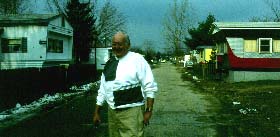
Beginning in the 1950s, the family started to sell parcels of land to developers.43 The former farm land surrounding the trailer park and the Farrington house was soon built up with tract housing and commercial development. Of the original 85-acre farm, about 10 acres remains in the Farringtons possession. Aerial photographs from 1962 and 1976 illustrate the growth of the trailer park and the commercial and residential development along North Avenue during that time.

When George Farrington, Jr. died in 1966, he left the trailer park and other family enterprises to his son James and his wife Sandra, who now owns the park . Farrington's also continued to incorporate trailer sales with the park business until the mid-1970s.45

Farrington's continued to grow through the 1970s, but unlike the specialty parks of the sunbelt states, it never attempted to cater to one particular type of tenant or add recreational amenities. Services in the park appeared incrementally. City water and sewer hookups for each trailer were installed in the mid-to-late 1950s. The installation coincided with the construction of the Ethan Allen Shopping Center, begun in 1954 and sited directly across the street from the Farrington property.40 The roads in the park were originally dirt but were paved in the late 1960s or early 1970s. Small street lights were also put in, probably at about the same time. Mail collection for each unit was established in the early 1950s.41
Today each mobile home has its own freestanding mailbox. Originally, trash collection was provided by the Farringtons. James Farrington recalls maintaining an incinerator on the property to burn the accumulated trash.42 It is now collected by an outside company.